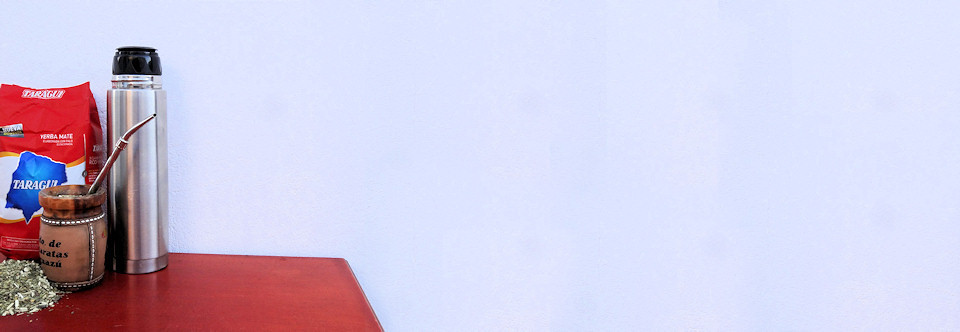In this post, I want to elaborate on a charming Argentinean (and Uruguayan) custom – that of ‘tomando mate’. Mate (pronounced ‘mah-teh’) is a herbal tea, served in a ‘Mate’, a cup traditionally made from dried out pumpkin but can be found in all shapes and sized from such materials as pumpkin, leather, glass, wood and metal or a mixture of such.
Health-wise, Mate has various beneficial properties such as its function as a digestive aid and the purifying effects of a diuretic. It also helps to reduce cholesterol in the body while delivering antioxidants. Its stimulative effect on the body aids in better attention and is not addictive like coffee due to a smaller proportion of caffeine than coffee, tea and chocolate.
The ‘Yerba’ or ‘tea’ is sold in large packets and has the consistency of fine chaff. Typically green in colour, the Yerba is often mixed with other herbs such as mint, boldo or palo, each adding distinct flavours and properties to the resulting brew. My personal favourite is a Yerba ‘elaborated’ with boldo (a bitter green herb) and mint. To begin with I would drink it with a small amount of sugar but now I prefer it strong and bitter.
Mate, Bombilla, Termo – Listo!
Originating from the river basin of Paraná, Paraguay, Yerba Mate was drunk by the indigenous Garaní of the region and through localised trade its consumption spread to other areas of South America. When Spanish colonisers arrived, this custom survived the systematic decimation of indigenous cultures and was actually adopted by the colonisers, spreading throughout Argentina, what is today Uruguay and parts of southern Brazil and Chile. In southern Brazil and Paraguay, a brew called Tereré is consumed cold due to the hot climates of those areas and the recipe varies slightly in that a mixture of different herbs are brewed.
The Mate is filled with Yerba and hot (but not boiling) water is added. After a brief period to let it steep it is sipped slowly through a kind of metal straw called a ‘Bombilla’ (‘bomb-bee-sha’ in Argentina and Uruguay, or ‘bomb-bee-ya’ in other parts). The Mate is refilled often, and only a small amount of water is added each time. You NEVER drink mate from the rim of the mate. Given that the Yerba is loose, the Bombilla also serves to filter the tea.
There is a whole custom surrounding how to serve and drink Mate – it is the Argentinean (and Uruguayan) equivalent of the Japanese tea ceremony. Variants of the custom, including the blends of yerba vary from country to country but in general the rules are as follows:
Once Mate is offered and accepted, one person will ‘cebar’. That is to say, one person will serve. This Spanish verb is ONLY used in relation to Mate, nowhere else. The ‘server’ will prepare the Mate and administer the hot water. You do not mix, shake or swirl the brew. A ‘ronda’ or ’round’ is established but the server will be the first to drink – it is their responsibility to ensure the brew is good. From there the round is observed, one refill for each person for each round. Don’t slurp excessively once the Mate is dry. Do not say thank you when you give it back to the server either, this means you don’t want anymore and will be excluded from the preceding rounds. Also, don’t hand an empty Mate to the next person in the round automatically – that’s bad fortune and you must compensate by giving the person something as a gift!
It is an enchanting custom, and I have embraced it whole-heartedly. Mind you, this custom is loosely followed, but those are the rules. It can also be drunk alone. The taste is strong and bitter and I find it satisfying. It does have caffeine-like effect making it an effective replacement for coffee if you need a stimulant. It is the perfect accompaniment to sitting in the park, or chatting with a friend. As I write this, on the bus from Punta del Este to Montevideo in Uruguay, the bus attendant is seated next to the driver, looking forward at the highway slowly sipping mate. Thermos in one hand, mate in the other. This is one detail which I love about Uruguayans and I will elaborate on that in another post.










